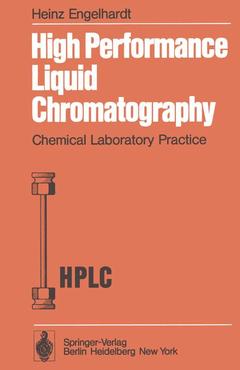Description
High Performance Liquid Chromatography, Softcover reprint of the original 1st ed. 1979
Chemical Laboratory Practice Series
Author: Engelhardt Heinz
Language: English
Subjects for High Performance Liquid Chromatography:
Approximative price 84.35 €
Subject to availability at the publisher.
Add to cart
High Performance Liquid Chromatography
Publication date: 12-1978
Publication date: 12-1978
Approximative price 52.74 €
In Print (Delivery period: 15 days).
Add to cart
High Performance Liquid Chromatography
Publication date: 01-2012
254 p. · 17x24.4 cm · Paperback
Publication date: 01-2012
254 p. · 17x24.4 cm · Paperback
Description
/li>Contents
/li>
Modern liquid column chromatography (LC) has developed rapidly since 1969 to become a standard method of separation. If the statisticians are to be believed, the recent growth of LC has been the most specta cular development in analytical chemistry and has not yet abated be cause its vast potential for application remains to be fully exploit ed. Significant factors contributing to this continued rise are the simplicity and low cost of the required basic equipment and the rela tive ease of acquiring and interpreting the data. Unfortunately, in LC, as so often in the field of analytical chemistry, the available commercial instruments are frequently far more complicated - and consequently far more expensive - than is nec essary for routine application. Therein also lies the risk of propa gating a "black box" philosophy that would be particularly detrimen tal to chromatography. Moreover, it appears to have been forgotten, as was done previously with gas chromatography, that inadequate sep aration by a column can be remedied only with great difficulty, if at all, by electronic means. Also, whether the capillary columns recent ly advocated with great enthusiasm for LC will fulfill the expecta tions of their proponents is highly questionable unless someone comes up with some new and revolutionary ideas.
I. Chromatographic Processes.- References Chapter I.- II. Fundamentals of Chromatography.- A. Retention.- B. Linear Flow Rate, Porosity, Permeability.- C. Band Broadening.- D. Resolution.- E. Dependence of Band Broadening on Flow Rate.- F. Band Broadening and Particle Size.- G. Extra-Column Band Broadening.- H. Optimum Analysis Conditions and Analysis Time.- I. Selection of a Suitable Column.- References Chapter II.- III. Equipment for HPLC.- A. Solvent Reservoir — Degassing of the Eluent.- B. Pumps.- 1. Syringe-Type Pumps.- 2. Reciprocating Piston Pumps and Diaphragm Pumps.- 3. Pumps with Variable Stroke Frequency.- 4. Gas-driven Displacement Pumps.- C. Damping of the Pulsations.- D. Sample Introduction.- 1. Sample Loops.- 2. Injection Devices.- E. The Column.- 1. Column Materials.- 2. Column Shape.- 3. Column Connections.- 4. Column Packing.- 5. Characterization and Testing of Columns.- F. Thermostating.- G. Measurement of the Flow Rate.- H. Fraction Collectors.- I. Recorders.- J. Instrumentation for Gradient Elution.- K. Safety Measures.- References Chapter III.- IV. Detectors.- A. UV Detectors.- B. Differential Refractometer.- 1. Fresnel-Refractometer.- 2. Deflection Refractometer.- C. Microadsorption Detector.- D. Transport Detector (Flame Ionization Detector).- E. Fluorescence Detector.- F. Other Detectors.- 1. Electrochemical Detectors.- 2. Conductivity Detector.- 3. Capacity Detector.- 4. Radioactivity Detectors.- 5. Directly Interfaced HPLC-Mass Spectrometry.- 6. Infra-red Detector.- 7. Other Methods.- G. Comparison of the Important Detectors.- H. Reaction Detectors.- References Chapter IV.- V. Stationary Phases.- A. Packing Materials for Adsorption and Partition Chromatography.- 1. Silica Gel.- 2. Alumina.- 3. Polyamides.- B. Chemically Modified Supports.- C. Ion Exchangers.- D. Stationary Phases for Exclusion Chromatography.- References Chapter V.- VI. Adsorption Chromatography.- I. Polar Stationary Phases.- A. General.- B. Stationary Phases.- C. Effect of Water on Separations.- D. Effect of Eluent on Separation.- 1. Eluotropic Series.- 2. Choice of Eluent.- 3. Solvent Mixtures.- E. Effect of Sample Structure.- II. Nonpolar Stationary Phases.- A. General.- B. Reversed Phase Properties.- C. Effect of Solvent on Separation.- D. Effect of Sample Structure.- III. The General Elution Problem.- A. Pressure or Flow Programming.- B. Temperature Programming.- C. Programming of the Stationary Phase.- 1. Variation of Adsorbent Activity.- 2. Coupled Columns.- D. Gradient Elution. Programming of the Eluent Composition.- IV. Applications of Adsorption Chromatography.- A. On Polar Stationary Phases.- B. On Nonpolar Stationary Phases.- C. Separations on Polyamide.- References Chapter VI.- VII. Partition Chromatography.- A. Introduction.- B. Supports and Liquid Phases.- 1. Supports.- 2. Liquid Phases.- 3. Coating the Support.- 4. Determination of the Coverage.- C. Properties of the Column.- 1. Stability.- 2. Sample Capacity.- 3. Preparative Applications.- 4. Column Efficiency.- 5. Programming Techniques.- D. Applications.- E. Ion-pair Chromatography.- References Chapter VII.- VIII. Ion-Exchange Chromatography.- A. Principle.- B. Ion Exchange Materials.- 1. Ion Exchangers with an Organic Polymer Matrix.- 2. Polymeric Ion Exchangers on PLB Particles.- 3. Brush Type Ion Exchangers.- 4. Liquid Ion Exchangers.- C. Characterization of the Ion Exchangers.- D. Optimizing a Separation.- 1. The Effect of pH on Retention.- 2. Effect of Ionic Strength on Retention.- 3. Change of the Buffer Solution.- 4. Other Effects.- 5. Gradient Elution.- E. Applications.- 1. Classical Ion Exchangers in HPLC.- 2. Porous Layer Beads (PLB).- 3. Ion Exchangers on Chemically Modified Silica Gel.- References Chapter VIII.- IX. Exclusion Chromatography. Gel Permeation Chromatography.- A. Introduction.- B. Basics of Exclusion Chromatography.- C. Stationary Phases for Exclusion Chromatography.- D. Applications of Exclusion Chromatography.- 1. Determination of the Molecular Weight Distribution of Polymers.- 2. Application of Rapid Exclusion Chromatography to Biochemical Problems.- References Chapter IX.- X. Selection of the Separation System.- References Chapter X.- XI. Special Techniques.- A. Preparative Chromatography.- B. Qualitative Analysis.- C. Quantitative Analysis.- D. Trace Analysis.- References Chapter XI.- XII. Purification of Solvents.- References Chapter XII.
© 2024 LAVOISIER S.A.S.




